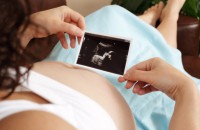Preggie Pals
Resuming Your Sexual Relationship After Pregnancy
[00:00:00]
Please be advised, this transcription was performed from a company independent of New Mommy Media, LLC. As such, translation was required which may alter the accuracy of the transcription.
[Theme Music]
SUSAN MELNIKOW: As you come to the end of your pregnancy, sexual activity may be the last thing on your mind right now. But eventually you and your partner will be interested in resuming sexual activity. How can you prepare for your birth in a way that will make it easier to restart sexual intercourse? How do you reignite that spark after a vaginal delivery where there was some trauma well at the same time avoiding pain? I’m Susan Melnikow, certified nurse midwife and today we’ll be discussing resuming your sexual relationship after pregnancy. This is Preggie Pals, episode 91.
[Theme Music/Intro]
ANNIE LAIRD: Welcome to Preggie Pals broadcasting from the Birth Education Center of San Diego. Preggie Pals is your weekly online, on-the-go support group for expecting parents and those hoping to become pregnant. I’m your host Annie Laird. Thanks to all of our loyal listeners who have joined the Preggie Pals Club. Our members get special episodes, bonus content after each new show, plus special giveaways and discounts. See our website for more information. Another way for you to stay connected is by downloading our free Preggie Pals app, available in the Android and iTunes market place. Now our producer Sunny is going to tell you a little bit more about our virtual panelist program.
SUNNY GAULT: Hey everybody, if you are not in the San Diego area where we broadcast our shows, you can play a part. We want you to become part of this, we want you to submit questions and we want to answer all the questions you guys have about the topics that we record on a regular basis. So, here’s what you need to do. You need to like our facebook page for those of you that are on facebook. If you are on twitter, you can follow us at Preggie Pals and look for #preggiepalsvp. So what we’re going to do is as we’re recording here in the studio and even before we start recording, we’re going to start posting questions that we’re going to be asking our panelist here in the studio. And you’ll have an opportunity to submit any kind of feedback you have on the questions that we’re asking. And then we’ll start to use those comments within our show. And then at the end of the day after we’re done with all of our tapings we’re going to pick a winner and that winner will get a free one month subscription to the Preggie Pals club. So, it’s fun way to get involved even if you’re not here in beautiful sunny San Diego.
ANNIE LAIRD: It is, yeah, I’m from Wisconsin so, my mom was telling me it was like negative two degrees yesterday so, yeah no thank you. I’m so sorry for those of you that are listening that are not in San Diego. I feel your pain. I waited out on the bus stop in ten degree weather too so I know that’s, that’s no fun. Alright, so let’s get go on with our panelist introductions; I’m your host Annie Laird. I have three kids, an eight year old, a toddler and then my baby who is getting so big. She is three months old and already like sixteen, seventeen pounds. It’s crazy, those breastfed babies, I’m telling you. Yeah they gain like gain busters. I don’t think she’s on the growth chart anywhere. My day job is I work as a government contractor as a teacher to sailors basically so that’s a lot of fun too. Then I do this on a weekend so, let’s go around the table
SUNNY GAULT: So, I’m Sunny, I’m producing today’s show. You guys know me, I am the former host of Preggie Pals and I just handed over the reins to Annie. So, I’m helping out today in the studio with all the virtual panelist stuff as we mentioned earlier. I am a mommy of four. I have two boys, my oldest is Sayer, he’s three. My middle guy is Urban and he is about twenty one, twenty two months right around in there. I think he’s about to have a crossover you know kind of that kind of thing. Anyways, and then I‘ve got twin identical girls. Ainsley and Addison, right now I have to look at the wrist bands tonight. Right now Addison’s in the studio with us now. She’s totally conked out from mommy’s milk and who knows, Ainsley may be joining us. If she squawks, I’m going to go get her, I’ll bring her in. So that’s, that’s the baby noise you may or may not be hearing throughout this episode
ANNIE LAIRD: We just like to keep it real in here. You know, this is motherhood. This is how life happens. Yeah
NANCY BAILEY: I’m Nancy Bailey, I work with Annie and I’m also a military wife and my husband and I are expecting our first child, a little girl in May, so I’m excited to be here
ANNIE LAIRD: Yeah
SUSAN MELNIKOW: And I’m Susan Melnikow. I’m a nurse midwife and mother of one daughter who is almost thirty. Ready to be a grandma but that hasn’t happened yet. And I have practiced in home, hospital and birth center. I was at Best Start Birth Center for the last four years and I am currently in the process of opening a birth center in Encinitas, California. And also working with the hospitals program at Scripps Encinitas
ANNIE LAIRD: Great
[Theme Music]
ANNIE LAIRD: Alright so news article, a lot of times for Preggie Pals episodes we go in to fun news headlines or interesting news headlines having to do with pregnancy. So, our news headline for today is tiny mom gives birth to the biggest baby ever born in California. So Vanessa Cervantes, she already knows she has had large baby she’s five foot one, a Californian mom
ANNIE LAIRD: Huh?
SUNNY GAULT: I was going to say she already knows she has big babies, I said AKA Annie Laird
ANNIE LAIRD: Oh yeah, no kidding yeah. My first born was a ten pound four ounces and the second one was almost eight pounds six ounces. Yeah so she was a little bit small
SUNNY GAULT: This story isn’t about you though right?
ANNIE LAIRD: It isn’t about me though no just checking. Vanessa she’s five one, already had two children, a ten pound ten ounce boy, nine pound fourteen ounce girl. And her newest son Andrew Jacob Cervantes, he entered the world at fifteen pounds two ounces.
SUNNY GAULT: Ouch
ANNIE LAIRD: I know right? Yeah, yeah so she, she had an emergency c-section, so she visited the doctor at thirty eight weeks, doctor said hey the baby’s movement have gone down. I can’t even imagine, so, I mean how big we’re your babies I imagine you’re, you’re twins were
SUNNY GAULT: Yeah my first. Yeah so look yeah so my first was a vaginal birth that’s the only vaginal birth I had and he was nine one so still not as big as your babies. But he came out looking huge to me. And then Urban my middle guy was like just over seven pounds, yeah and he was born at thirty eight weeks. And then the twins, I can’t really, I mean they were preemies so it’s really hard but they were born at thirty five weeks and right about five and a half pounds
ANNIE LAIRD: I think that’s just, isn’t that and Susan you probably be able to chime on that when you do have twins, that’s a good thing when they’re close in weight like that right
SUSAN MELNIKOW: It’s very good it means they’ve been growing equally through the pregnancy
ANNIE LAIRD: Yeah you definitely don’t probably that will be harder on one if you had like a seven pound twin and then a four pound twin, yeah
SUSAN MELNIKOW: It does happen, but it’s good when they’re pretty close together
ANNIE LAIRD: Susan how old, big was your daughter when she was born?
SUSAN MELNIKOW: She was seven and a half pounds.
ANNIE LAIRD: Oh see it nice.
SUNNY GAULT: Right in the middle.
ANNIE LAIRD: Exactly yeah exactly. Now do you know how, Nancy how big you were when you were born or your husband?
NANCY BAILEY: Oh no, I don’t. I’ve never asked my mom and now this makes me want to do something.
SUNNY GAULT: Got to do some homework on that.
NANCY BAILEY: I guess if I was too big I would, I would know that fact in every lecture she ever gave
ANNIE LAIRD: Yeah, I mean my husband, he was a ten four, ten pounds four ounces when he was born and his mother calls him every birthday every April 22nd, I was in labor for three days with you. Grandma Laird I love you very much if you’re listening to this podcast I appreciate, your son appreciates everything that you did to give birth to him but yeah of course then my first born was also ten pounds four ounces
SUNNY GAULT: That is insane
ANNIE LAIRD: Yeah
[Theme Music]
ANNIE LAIRD: Today on Preggie Pals we’re discussing resuming your sexual relationship with your partner after you have a baby. Joining us today is our expert panelist Susan Melnikow, Melnikow? Let’s just do that again. Joining us today as our expert panelist is Susan Melnikow. Susan has been a certified nurse midwife for thirty years. She’s practiced full scope midwifery in home, birth centers and hospitals. And she’s preparing to open her new birth center Tree of Life for healthy birthing and parenting. Susan welcome to the show and thanks for joining us
SUSAN MELNIKOW: Thank you so much. I’m really happy to be here
ANNIE LAIRD: Yeah. You know you’re experience as midwife can really contribute today at talking at some of the birth practice women should consider as they go into their birth. I imagine that that really has a lot to do with how easy it is going to be to start back up having sex. Now, what kind of birth practices should women be considering?
SUSAN MELNIKOW: Well one of the things, first of all is that women should remain pretty active during the pregnancy. You know walking is I have found that women who walk throughout the pregnancy have shorter and a little bit easier labors. So it’s very important to stay active, be exercising. You know squatting is a really good thing to help the perineum stretch and if you can keep yourself really agile up through the end of the pregnancy that will help with the labor to start with. And then, women should be talking to their care provider, their doctor or their midwife about their rates of episiotomy and what their feelings are about episiotomy.
ANNIE LAIRD: Now does like the World Health Organization, do they have a percentage or something like that. I know they have that for c or they have that for c section I don’t know if that’s the case anymore is there a rate that they say, episiotomy should be below x number or no
SUSAN MELNIKOW: I don’t actually know that, but I do know that we’re very lucky, we’re changing a lot. The American College of American Congress of Obstetricians and Gynecologists no longer recommends episiotomy. Many obstetricians are now learning through their residency programs how to catch babies without performing a, an episiotomy. So that’s what is the standard at this point. Now, some of the older physicians didn’t learn that. So, I think it’s a little harder if you’ve been practicing for a long time. Exactl! But that is an important discussion to have to every pregnant woman should have with their care provider in terms of the thoughts about episiotomy and what the rates of episiotomy are for their provider.
ANNIE LAIRD: What will be a reason that an episiotomy look like would be needed?
SUSAN MELNIKOW: You know I’m wondering Annie if we even need to define what an episiotomy is for those audiences that might not know what that is
ANNIE LAIRD: Yeah that’s a great question
NANCY BAILEY: That’s what I figured out from the context clues. Weighting it out was such
SUSAN MELNIKOW: An episiotomy is actually a surgical cut that is made in the perennial skin. And the perennial skin is that area between the opening of the vagina and the opening of the rectum
ANNIE LAIRD: Okay
SUSAN MELNIKOW: And for many years that was how obstetricians learned how to deliver a baby. That it should be part of the process. And we now know that
ANNIE LAIRD: Nancy’s shaking her head right now, Oh dear Lord
NANCY BAILEY: It’s not what I thought it was
SUSAN MELNIKOW: Okay, so I’m glad we defined it. In past decades that was seen as a routine part of giving birth vaginally. Luckily now we realized that the, a woman’s body has a wonderful propensity to stretch around the baby’s head and then it really should not be necessary as a routine procedure. So, the way most midwives look at it and I believe most doctors now is that it is really kind of an emergency procedure. When we do need to expedite the birth. I personally do it if, if I’m concerned about the baby, if I hear the baby’s heart rate going down. And this, usually it’s not done until the baby’s head is crowning. We can see a full crown of the baby’s head. And that’s when it’s appropriate to be done. And I usually don’t do it at all unless I’m hearing a problem with the baby’s heartbeat. Or if I can tell that we’re going to end up having a tear that’s going to be much larger than a little snip would be. So
ANNIE LAIRD: Well I guess that kind of goes into my next question then, is it better to tear naturally than to be having an episiotomy cut?
SUSAN MELNIKOW: In general, it is better to tear naturally. It usually doesn’t go through the muscle layer if you tear a little bit. Usually just the skin in the vaginal mucosa will tear and we can stitch that back up really easily under local anesthetic.
ANNIE LAIRD: Okay
SUSAN MELNIKOW: Yeah
ANNIE LAIRD: Yeah. Now how does tearing, how does that affect resuming the recovery basically the pain after child birth
SUSAN MELNIKOW: It does make a difference. And it depends on how many stitches there were and kind of how extensive the either the tear or the episiotomy was.
ANNIE LAIRD: Yeah
SUSAN MELNIKOW: And most women heal really well and by about four to six weeks are really ready to be sexually active again. But some women aren’t. And so that needs to be taken into account. So, it’s real important that you know adequate care is given of these stitches afterwards
ANNIE LAIRD: Yeah. Yeah, I mean I tore with, I have three vaginal births under my belt as it were and two of them I tore one I didn’t. And it was interesting because two of them I think were the same degree of tear. There was a second degree of tear but one recovery was much harder than the other. I don’t know why that was and so
SUSAN MELNIKOW: It’s always hard to say it could be where the tear occurred
ANNIE LAIRD: That’s true. Yeah
SUSAN MELNIKOW: It could be how much sleep you were getting afterwards. I don’t know if your whole recovery was different because that can happen. When, you know, women oftentimes becomes sleep deprived when they’re taking care of their babies and that can make a difference in how the healing goes. How active you are. It’s real important to take those couple of weeks and really be at home and not be out and about a lot. Taking naps in the afternoon, just really doing a lot of self-care to make sure that that will facilitate the healing as well
ANNIE LAIRD: Okay. Now backing up a little bit more, is there any evidence for a perineum massage, so we’re talking, what are your thoughts?
SUSAN MELNIKOW: I had it times during pregnancy you’re talking about?
ANNIE LAIRD: Yes, yeah
SUSAN MELNIKOW: Yes. It’s very interesting
ANNIE LAIRD: And what is perennial massage, I guess we should you know define that as well
SUSAN MELNIKOW: Perennial massage is when that area of skin can be massaged with just a finger or two either by the woman herself or by her partner. Using a lubricant you know
ANNIE LAIRD: Yeah I was to say that would probably have to be like the, I mean I’m trying to think of how big my belly was at the end. And Sunny gosh you had twins. So, you know imagine a partner’s help would be needed sometimes
SUSAN MELNIKOW: Well it’s really interesting because I’ve come in the thirty years I’ve been practicing I’ve come full turn on what I think about this. Previously when I was a nurse and a child birth educator I was teaching all women to do perennial massage and I thought it would make a big difference. And as a midwife I’ve kind of realized over the years that I don’t think it really makes a huge difference. And so I leave it up to the women I tell her about it but I leave it up to her. Some women really feel like they’re doing something proactive and they think it will help. And other women find it very uncomfortable and don’t want to do it at all
ANNIE LAIRD: Yeah
SUSAN MELNIKOW: So, I think either way is perfectly fine. I’m not sure it makes a big difference.
ANNIE LAIRD: Yeah. I know in my childbirth education class they were talking about you know doing it to the point of like stretching intensely but not burning in pain. I’m like this is some like something that I want to engage in I’m like oh my gosh you know so
SUSAN MELNIKOW: I find that most women stretch just beautifully as they had to sense thru the vaginal canal. And that you know the more that we are hands off and leave everything alone, the baby and the mom’s body know what to do.
SUNNY GAULT: Just a quick note to our listeners out there we did a whole episode on episiotomies, tearing and perennial massage. So, check out the episode guide on our website for all that information
ANNIE LAIRD: Oh great. Good. What about lukewarm compresses would that be something that as the baby is being born that something that would make it less traumatic?
SUSAN MELNIKOW: That will facilitate it definitely. The warmth helps the tissues to relax you want the muscles to be relaxed. And that warmth usually feels really good for many women and that will help providing counter pressure. As the baby’s head is crowning, as a midwife I always put my hand against the perennial area to support it. And I find that that also helps the area to stretch. You know its counter pressuring against the force of the baby’s head as it’s coming through. And in some first time moms who have a long second stage where they’re pushing for several hours. I have actually used ice rather than heat. And I have found that that’s been really useful because with long pushing periods sometimes the perennial area will swell. And when you use ice, moms tell me it feels really good in it, it decreases the swelling so then they’re less likely to tear as well
ANNIE LAIRD: That’s great
SUSAN MELNIKOW: Yes. So, it’s very individual with each mom
ANNIE LAIRD: Well great when we come back, we’re going to be discussing c section and recovery from that as far as it relates to resuming sex. We’ll be right back
[Theme Music]
ANNIE LAIRD: Welcome back, today we’re talking about resuming your sexual relationship after childbirth. Susan up to this point we talked about vaginal birth, but in one in three women here in the United States they do have a cesarean birth, so how is that different? How is that recovery different as far as resuming the sexual relationship?
SUSAN MELNIKOW: For the mom’s who’ve had a cesarean, the issues are going to be a little different. Usually they don’t have issues with their perennial area or their vaginal area. But they do have issues with the incision in their abdomen for the cesarean. So they want to make sure that that has completely healed you know that it’s some it’s all intact and it looks good and it’s healing well. Oftentimes they have more pain for a longer period of time in the abdominal area where the incision is. So, that can affect a mom in terms of her readiness to be sexually active again. If she’s still having some discomfort, she may not be ready
ANNIE LAIRD: Yeah. Now going on the other side of this though, I’m sure there are women that say I felt, I feel fine, you know, two weeks after having a baby. What are the considerations, I mean is there a reason why a woman if she felt up to it obviously her partner would probably felt up to it unless he was up baby about or whatever you know. He’s sleep deprived too but I mean, what are the, are there any risk to of having sex before the period
SUSAN MELNIKOW: For a vaginal birth we just for both well for all women, you want to make sure that you’re not bleeding any longer. You want the bleeding to have subsided, because that is your body’s way of telling you that your cervix is now closed
ANNIE LAIRD: Oh okay. How long does that normally take, how long do women usually bleed?
SUSAN MELNIKOW: Some people will stop about two weeks and other people won’t stop till six weeks.
ANNIE LAIRD: And I was like seven weeks where teaching my kid it sucked, so yeah
SUSAN MELNIKOW: So, usually after a vaginal birth it takes two to three weeks for the cervix to close down. And usually that will be reflected in the bleeding. And if most of the bleeding’s gone and it’s only a little tiny bit of spotting and you’re two to three weeks out it’s probably fine to begin and be sexually active again.
ANNIE LAIRD: Okay.
SUSAN MELNIKOW: For a cesarean, usually two weeks might be a little soon for the incision. You know I would, it’s again everything is very individual. Women are unique beings and so we can’t just say there’s a total rule of thumb that this is what happens. But you would want to make sure that that incision is completely you know healed. It has dried, it’s not, there’s no chance that it would open.
ANNIE LAIRD: Yeah, now Sunny you’ve had two cesareans at all or I’m sorry yes you’ve had two cesareans. So, I mean how does that work, are there stitches that need to be taken out or staples, you know, you’d be able to give a you know better testimonial of kind of what the healing process is there postpartum
SUNNY GAULT: Well I was actually different for the two births that I had cesareans for. So, for my first one they did staples. And then they took those out before I left, you know so it’s in the hospital for a few days and then they took those out, which I thought was going to be really painful. It’s actually really not that painful when they take them out. I’m like taking staples out sounds really painful, but it wasn’t. And then with the, with the twins, I, I’m going to get the name of it wrong and maybe Susan you would know better but they didn’t do staples I was expecting staples because it was the same hospital and everything. And it was something like I can’t remember, invisible something
SUSAN MELNIKOW: Well they’re doing, they’ve gone to doing sutures, under the skin. And they feel like it leaves less of a scar than the staples do
SUNNY GAULT: I don’t think they were, I don’t think they were sutures
SUSAN MELNIKOW: There’s also a type of glue is that what you’re talking about. And you know what the official name of it is
ANNIE LAIRD: Super Glue
SUSAN MELNIKOW: Yeah it is like super glue, it’s a medical super glue that’s being used.
SUNNY GAULT: Yeah. I think that’s what they told me because I didn’t really, I didn’t really look at the scars or anything actual. Because I have few bandaged up and stuff and believe it or not I mean I don’t know for people out there who haven’t had a cesarean yet, you still bleed. You bleed a lot afterward because I was thinking oh well it’s coming out of my belly it’s not coming out of me vaginally, I’m not going to bleed.
ANNIE LAIRD: But the lining of the uterus still has to come out
SUNNY GAULT: Yes. Exactly, so I was shocked at how much you know I bled vaginally. I really didn’t look at it too much and then when I went to be discharged I said well you take my staples out right, and they’re like oh you don’t have staples. I’m like what? This whole time I was thinking I had staples so yeah anyways that was my experience with the stitching or whatever this staples is
ANNIE LAIRD: I mean I had a ectopic pregnancy when my first daughter was, she was only eight year old, but yeah I had the staples as well. And remembering the same thing going oh my gosh like I was dreading the appointment I’m like cold sweats and sweaty palms like oh this is going to be awful. But compared to, compared to you know nearly
SUNNY GAULT: Giving birth
ANNIE LAIRD: Yeah compared to giving birth, yeah I had epidural for number birth number one that worked beautifully much. Susan the first time that a woman has sex you know I mean she goes in to her OB, her midwife, gets the A okay at the sixth week appointment. Is sex, when you have sex for the first time is pain to kind of being expected as par for the course?
SUSAN MELNIKOW: I have found that it’s very individual. And the other thing to take we have to step back for a minute and look at women’s readiness to be sexually active. I find that that’s extremely variable also. You need to look at what’s going on if your breastfeeding your baby; you have a whole different concoction of hormones in your body. Which can affect your libido, because you have a lot of cuddling time with the baby you’re secreting dopamine and oxytocin and those are the hormones that get secreted when you have an orgasm.
So, oftentimes women’s libido goes down after they’ve given birth. And they may not have the same desire. And again it’s very different, I’ve worked with a lot of women who were ready to be sexually active at two to three weeks and they just want the okay. And then I’ve worked with a lot of women who are not even ready at six weeks emotionally. So it’s very important to look at the larger context of where a woman’s at.
The other thing that I think is important is that, you know as women, we’re a little different sexually than men are. And the relationship factor, communication and the romance factor is extremely important and I have found that especially with postpartum women, they want to feel nurtured and they want to feel connected and communicative with their partner. And so all of that I think impacts their readiness to be sexually active again
ANNIE LAIRD: Yeah so hey guys, if you’re listening here that’s
SUNNY GAULT: Taking those for Valentine’s Day.
ANNIE LAIRD: Exactly taking those for Valentine ’s Day, you know according to Susan the midwife, you know if you want that sexual relationship to start a little bit sooner. You know doing the dishes and taking care of the children
SUSAN MELNIKOW: Exactly, it goes a long way
ANNIE LAIRD: Go a long way, you know
SUNNY GAULT: You know I’m almost wondering, when you’re talking about that nurturing relationship, I’m wondering if that’s because that’s what we we’re doing for nine months for our children, you know it’s that we’re so familiar with it because that’s what we’ve been doing for so long then it’s gone. And we’re looking for it else or maybe I’m getting a little you know psychologist
SUSAN MELNIKOW: Well I think it’s also important for women to acknowledge where there at and communicate that with their partners but also to understand where their partner’s at. Cause usually it’s real different after having giving birth. You know a woman’s body has been occupied by your baby for nine months. And now she is nurturing her baby. And she has constant physical contact with the baby she’s breastfeeding. And so that kind of meets a lot of her needs. But her partner doesn’t have that. And so it’s very important to come together and understand where each person is emotionally and psychologically and communicate about that so that they can come to a mutual
ANNIE LAIRD: Yeah, I don’t want to scare Nancy here, you know, first time mom, probably the most challenging transition was that “Oh I don’t have any kids and hey what restaurant you want to go out to Oh I don’t know let’s just drive around and pick one” to being the twenty four seven the constant need. Nobody told me about the fourth trimester, about just that intense connection to the baby and how needy they are you have to do everything for them
SUSAN MELNIKOW: Well that’s a huge transformation and I am birthing from within mentor and one of the things that we focus on is the postpartum period. And in the research that’s been done, it actually takes anywhere from three months to three years for a mom and a dad and a couple together to come back to a sense of balance in terms of who they are and where their relationship is at. It’s not usually just the six weeks like our society kind of thinks it is
ANNIE LAIRD: Now well Susan, to finish off here today let’s talk a little bit about breastfeeding your baby, how that can affect the hormones and vaginal dryness in some cases is that correct?
SUSAN MELNIKOW: Yes. That is correct. Well all the hormones were very different after birth as well as during pregnancy. They don’t go back to kind of the pre pregnant state until after you stop breastfeeding. So you need to take that in to consideration. And one of the side effects is that usually there is a lot of vaginal dryness so we always recommend a lubricant used in sexual activity when you’re breastfeeding. That will help tremendously.
SUNNY GAULT: Dou you have to be careful at all with like the spermicides and all that you know that comes with those creams and gels or whatever lubricants?
SUSAN MELNIKOW: In terms of the breastfeeding?
SUNNY GAULT: In terms of you know what you do like right after having a baby like when you’re ready to resume you sexual, I just wasn’t, I wasn’t sure of like that could cause an infection or you know anything like that
SUSAN MELNIKOW: No it’s okay to use those, I mean as long as the major part of your bleeding has stopped so that you can be assured that your cervix is closed. There shouldn’t be a risk with that.
ANNIE LAIRD: I guess that’s something to consider as well for our listeners that are pregnant, talking about you know birth control that is something that you know you need to think about that before you give birth. Unless you want to be like me and up and ahead and awful night last night you know being up just I mean I was.
SUNNY GAULT: Your kids can be your birth control really
ANNIE LAIRD: Oh I tell you what after number three that was after number two I was like oh let’s do it again. So we did, so like my kid, my number two and three are sixteen months apart and now with number three I’m like okay I need some like serious like birth control
SUSAN MELNIKOW: Exactly, so it’s a huge decision to make as to how you are going to prevent another pregnancy right away. A lot of first time moms don’t realize that
NANCY BAILEY: Oh it’s something I definitely thought about but haven’t done the research yet so
SUSAN MELNIKOW: Yeah. Many moms will not have regular periods while they’re breastfeeding and I’ve many moms will ovulate prior to having a period and they don’t know that they’re fertile again. And then they conceive
ANNIE LAIRD: Yes that was me, at work throwing up in the toilet, going wait a second. Well thanks Susan for joining us today. For more information about Susan and her midwifery practice as well as information about her new birthing center up in North County of San Diego, very excited. Visit the episode page on our website. This conversation continues for members of our Preggie Pals club. After the show Susan will be talking about talking to us about the nuts and bolts of starting up your sexual life again, what positions are the best ones to start to avoid discomfort? To join our club, visit our website www.preggiepals.com
[Theme Music]
JENNIFER DURBIN: Hi I’m Jennifer Durbin, the author of “Pregancy tips for the Clueless Chic” and a mother of two wonderful little boys. I’d love to share with you my tips for pampering yourself during your pregnancy. While you’re busy preparing for the arrival of your little one and all the craziness that will come with parenthood, don’t forget to take care of yourself and your partner. Having a baby is one of the most wonderful and difficult things in the world. And every mother will tell you that a baby instantly becomes your number one priority.
But for the sake of the baby and your sanity don’t forget to take care of yourself. Whether you plan to get a prenatal massage, spend a day at the spa with a girlfriend or even take a day off of work to do a whole lot nothing. It’s important to schedule some time for yourself before things get crazy. You may want to plan a fun pre baby girl’s night out or a date night where you are not allowed to talk about the baby. Those are fun ways to celebrate you. It’s also fun to step outside of your box if you’re in a funk and wear something super trendy that you might not normally wear.
If you’ve been cleared to exercise during your pregnancy, find a local prenatal yoga or aqua aerobics class. This is not only a great way to exercise but also the perfect way to meet other pregnant women. And finally, my favorite pamper yourself tip, make a list of all the pregnancy don’ts that you’ve been dying to do, like eating sushi or having a glass of wine. Then you can look for to checking off of your list after the baby is born. While you’re planning for some much needed pampering, don’t forget that your partner is on this wild ride with you. While you’re the one with all of the aches and pains who cannot tie her own shoes, your partner has been there to listen to all of your woes and be a shoulder for you to cry on when your hormones are raging.
Remember that time you spill grape juice on your brand new top and cried for two hours straight? So look for a special way that you can surprise him with his favorite dinner or night out with the boys. For more great tips, visit www.cluelesschick.com
[Theme Music]
ANNIE LAIRD: That wraps up our show for today, we appreciate you listening to Preggie Pals, don’t forget to check out our sister shows Parent Savers, for parents with newborns, infants and toddlers. Twin Talks for parents of twins and our show The Boob Group for moms who breastfeed their babies. Next week, we’re talking about how you know that you are in labor. This is Preggie Pals, your pregnancy, your way
[Disclaimer]
This has been a New Mommy Media production. Information and material contained in this episode are presented for educational purposes only. Statements and opinions expressed in this episode are not necessarily those of New Mommy Media and should not be considered facts. Though information in which areas are related to be accurate, it is not intended to replace or substitute for professional, Medical or advisor care and should not be used for diagnosing or treating health care problem or disease or prescribing any medications. If you have questions or concerns regarding your physical or mental health or the health of your baby, please seek assistance from a qualified health care provider.
[00:31:49]
[End of Audio]











